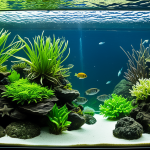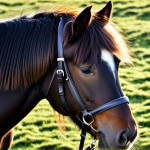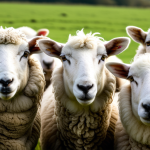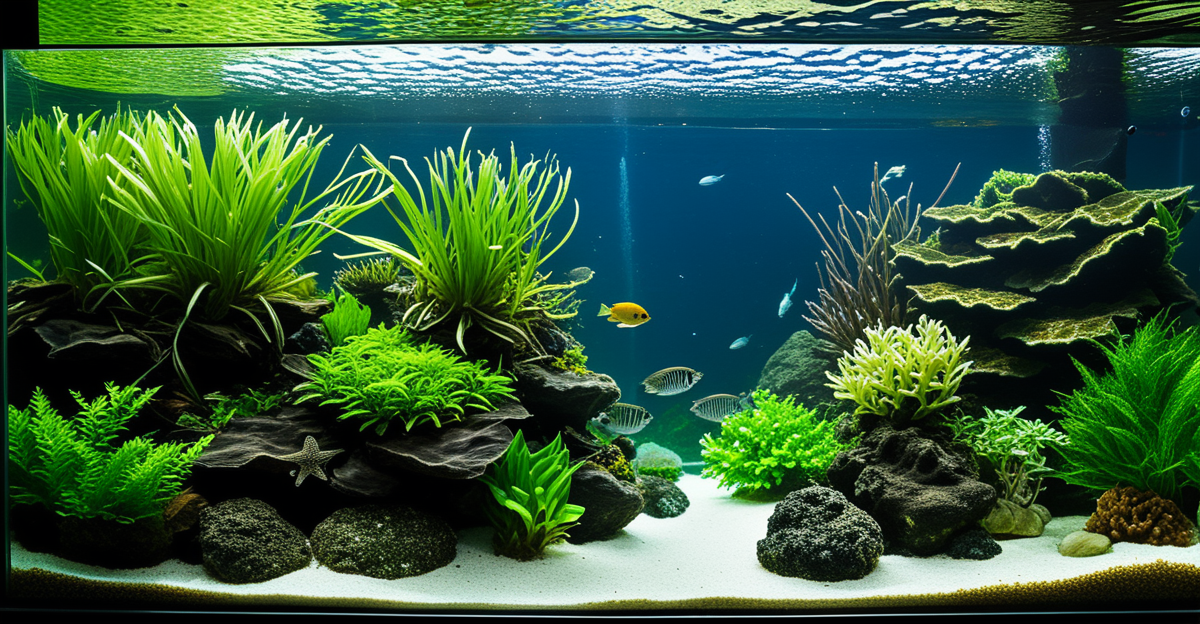Understanding British Native Freshwater Species
Creating a biotope aquarium centred on British native fish, aquatic invertebrates, and native algae offers a unique opportunity to simulate natural ecosystems and promote biodiversity. Key species integral to such aquariums include the stickleback fish, various caddisfly larvae under aquatic invertebrates, and greenish-brown algae found in British waters. These organisms, through their interdependent relationships, contribute positively to the aquarium’s health. For instance, sticklebacks, with their agile swimming patterns and territorial behaviours, add dynamic interest to the tank, while invertebrates like caddisfly larvae enhance the ecosystem by providing cleaning services and acting as a food source for fish.
The biodiversity present in an aquarium is critical as it mimics natural interactions, creating a stable environment and reducing algae overgrowth. Diverse species each play a role, whether through oxygenating the water, breaking down waste materials, or controlling pest populations.
Cela peut vous intéresser : Ultimate Guide to Preventing and Healing Saddle Sores in Shetland Ponies: Expert Tips and Tricks
Moreover, British native species are uniquely adapted to local environmental conditions like fluctuating temperature and water chemistry, making them well-suited for captivity. Their specific adaptations include resistance to cold and the ability to thrive in varied pH levels, which are essential traits for survival in the replicated habitats of a biotope aquarium.
Essential Habitat Requirements
Creating a successful aquarium ecosystem for British freshwater species requires understanding their natural habitats. These species thrive in water conditions that closely mirror their native environments. Typically, this includes cool temperatures ranging from 10°C to 18°C and a slightly acidic to neutral pH level, ideally between 6.5 and 7.5.
Dans le meme genre : Discover the Joys of Raising a Pet Sheep in Rural UK: Your Ultimate Guide
When it comes to maintaining these conditions, selecting the correct water parameters is crucial. A moderate hardness level is preferable, as it mimics many British freshwater systems. To ensure a healthy and stable environment, some aquarists suggest using peat filtration to replicate the tannin-stained waters native species often inhabit.
Substrate choice is also a pivotal aspect of recreating a natural habitat. Coarse sand or fine gravel can simulate riverbeds and lake bottoms, providing essential substrate for plant roots and offering a familiar setting for benthic invertebrates.
Water parameters should be monitored regularly to prevent any dramatic shifts, which could stress the resident species. Alongside this, the décor chosen should be representative of their native surroundings, incorporating natural elements like driftwood, stones, and aquatic plants that foster the fish’s natural behaviours and interactions.
Tank Setup and Design
Designing an effective aquarium layout means replicating the natural conditions British native freshwater species thrive in. Aquascaping plays a significant role in this, as it encourages natural behaviors and interactions among fish. Start by arranging stones and driftwood to simulate riverbeds, providing cover and territory for species like stickleback fish.
Incorporate a variety of textured plants to mimic natural vegetation, supporting biodiversity by offering shelter and breeding grounds. Create areas with both dense plantings and open spaces to satisfy different species’ needs.
The filtration system is crucial. It should mirror natural water movement, often achieved through gentle water circulators that avoid creating overly strong currents. Choose filtration methods such as sponge filters, which help aerate the water without disturbing the substrate.
A well-planned design not only enhances the aesthetic appeal of the biotope but also maintains a balanced ecosystem. By focusing on natural aquarium design, aquarists can create environments that greatly benefit the health and well-being of their aquatic inhabitants.
Invest time in researching and planning the layout to ensure that all elements work harmoniously together and mimic the varied environments found in British freshwaters.
Suitable Plant Selection
Selecting native aquatic plants is crucial in supporting biodiversity within a British biotope aquarium. These plants, adapted to local conditions, enhance the ecosystem by providing oxygenation, shelter, and breeding areas for fish and invertebrates. Common options include starwort, known for its lush greenery and ability to thrive in cool waters, and water mint, valued for its aromatic leaves and resilience.
When introducing plants, choose vegetation types that mirror natural British waters. This includes incorporating species like hornwort, which offers batchy cover and aids in reducing algae by competing for nutrients. Such plants not only beautify the aquarium but also play critical roles in sustaining a balanced environment.
To maintain healthy vegetation, ensure proper plant care by monitoring light exposure, using nutrient-rich substrates, and regularly pruning overgrown areas to facilitate growth. Consider the unique needs of each plant type, such as the preference for soft, slightly acidic water in certain species. By fostering the right conditions, aquarists can enjoy vibrant, thriving aquatic plants that improve the overall health and aesthetic appeal of their biotope aquarium. These efforts promote a dynamic habitat that reflects the diverse beauty of British freshwater ecosystems.
Care and Maintenance Practices
Maintaining a biotope aquarium simulating British native ecosystems involves some essential practices to preserve its health. Regular aquarium maintenance is crucial in sustaining the natural balance and enhancing the longevity of the species involved. Periodic water changes are vital for removing waste accumulation and replenishing essential minerals, generally recommending a 10-20% exchange weekly.
Routine health checks are non-negotiable, ensuring the wellbeing of the aquarium’s inhabitants. Observing fish behavior, checking for visible signs of distress, and attending to any plant decay support a thriving environment. Performing consistent water testing for parameters like pH, ammonia, nitrate, and nitrite is imperative to detect any negative shifts that could adversely affect the species.
Managing common health issues promptly is key to avoiding widespread problems. If algae overgrowth appears, reassess light exposure and nutrient levels, as these imbalances could flag underlying issues. By implementing these best practices, aquarists encourage an environment that mimics natural habitats, fostering a harmonious community among native freshwater species. Paying attention to these elements ensures that each component supports the other, preserving the aquarium’s beauty and functionality.
Case Studies and Personal Experiences
Drawing inspiration from hobbyist experiences can greatly enhance your approach to creating a successful British biotope aquarium. Many enthusiasts have shared biotope success stories, highlighting unique challenges and creative solutions. These examples provide practical insights into handling the delicate balance within an aquarium ecosystem.
One notable insight is the importance of understanding community dynamics among native species. Fish and aquatic invertebrates from similar habitats often display complementary behaviors, fostering a harmonious environment. Sticklebacks, for example, demonstrate natural territorial instincts but can co-exist with non-aggressive species like caddisfly larvae.
Engaging with fellow hobbyists can also illuminate unexpected benefits of particular setups. For instance, some enthusiasts have noted that using native algae not only enriches the aquarium visually but also stabilises water quality by enhancing filtration naturally. These shared experiences underscore the diversity in approaches and results, motivating new and seasoned aquarists alike.
By exploring these personal accounts, aquarists gain a deeper appreciation for the nuances involved in maintaining native British freshwater species. Embracing tips and learnings from others helps fine-tune methods, ultimately leading to thriving, biodiverse aquariums tailored to fit individual preferences and constraints.









